The biggest mistake that leaves you unprotected is applying too little sunscreen, often skipping critical areas like ears, neck, or behind knees. Many people fail to use enough product or miss spots altogether, which reduces the SPF’s effectiveness. Forgetting to reapply after swimming or sweating also weakens your defense against UV rays. If you want to stay protected and learn how to avoid these common errors, there’s more to contemplate.
Key Takeaways
- Applying too little sunscreen fails to provide adequate UV protection, leaving skin vulnerable to damage.
- Not reapplying sunscreen every two hours or after water or sweating diminishes ongoing protection.
- Skipping coverage on tricky areas like ears, neck, behind knees, and feet creates unprotected spots.
- Using expired or low-quality sunscreen reduces SPF effectiveness, compromising skin defense.
- Applying sunscreen immediately before sun exposure instead of 15-30 minutes prior reduces its protective benefits.
Skipping the Right Amount of Sunscreen
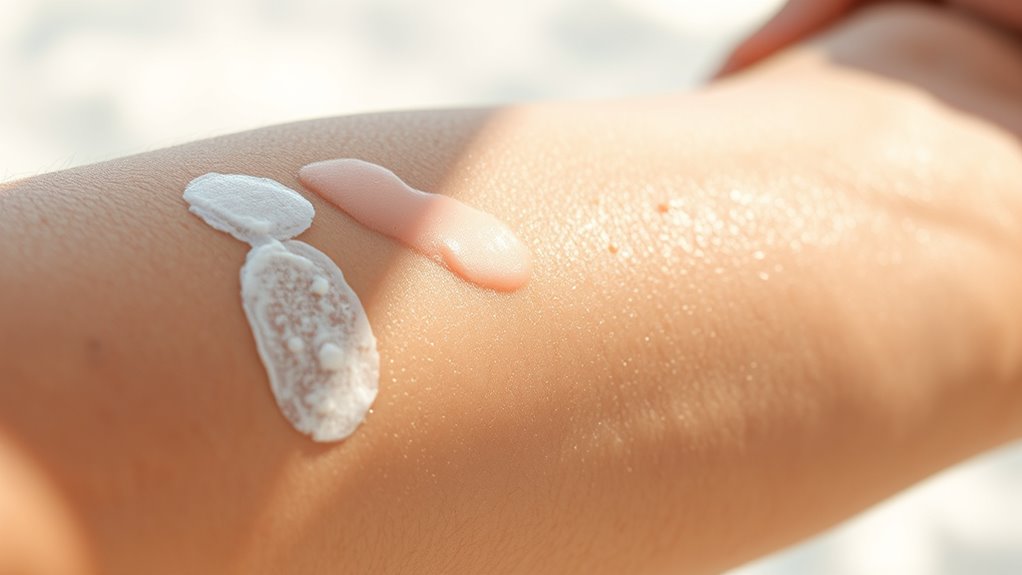
Many people underestimate how much sunscreen they need to stay protected. Applying too little leaves your skin vulnerable to UV rays, increasing your risk of burns and long-term damage. A common mistake is using just a small dollop or quick spritz, which isn’t enough to cover all exposed areas thoroughly. To make certain of proper protection, you should use about one ounce (a shot glass full) for your entire body, especially if you’re spending hours outdoors. Don’t skimp on quantity—spread it evenly across all exposed skin. Remember, even if you feel like you’ve applied enough, it’s better to add a bit more than to risk missing spots. Properly measuring and water efficiency consistently applying enough sunscreen is your best defense against UV damage. Incorporating self-awareness about your application habits can help ensure you’re not unknowingly leaving yourself exposed. Being mindful of your application technique can also improve coverage and effectiveness. Additionally, understanding the importance of coverage and thoroughness can help you avoid common application mistakes. Regularly inspecting your application process can further enhance your sunscreen effectiveness and overall sun protection strategy.
Applying Sunscreen Only Once
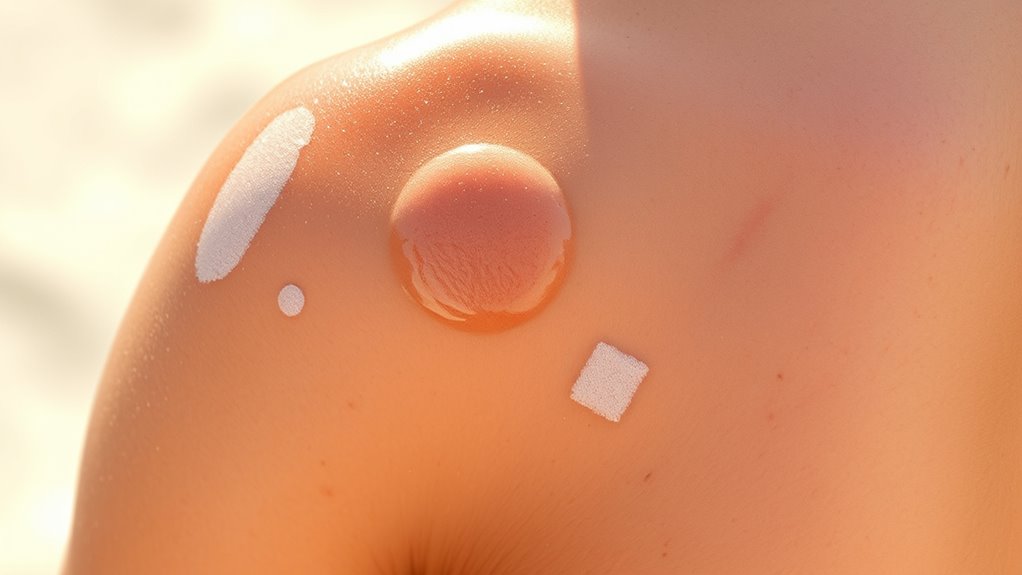
Applying sunscreen only once can leave your skin unprotected as UV rays continue to reach you throughout the day. Sunscreen doesn’t last forever; it wears off due to sweat, water, and rubbing. If you apply it once in the morning and stay outdoors for hours, you’re at risk of overexposure. Reapplying every two hours ensures continuous protection. Even on cloudy days or when you’re in the shade, UV rays can penetrate and cause damage. Understanding sunscreen durability can help you better time your reapplications for optimal defense. Remember, a single application isn’t enough to guard your skin against the sun’s effects throughout the day. Make it a habit to reapply sunscreen regularly, especially after swimming or sweating. This simple step helps maintain effective coverage and keeps your skin safe from harmful UV radiation. Regular reapplication is essential because broad-spectrum protection helps shield against both UVA and UVB rays throughout the day. Additionally, being aware of sunscreen effectiveness can help you choose products that provide longer-lasting protection. Using sunscreens with long-lasting formulas can also reduce the need for frequent reapplications and ensure more consistent coverage.
Forgetting to Cover All Exposed Areas
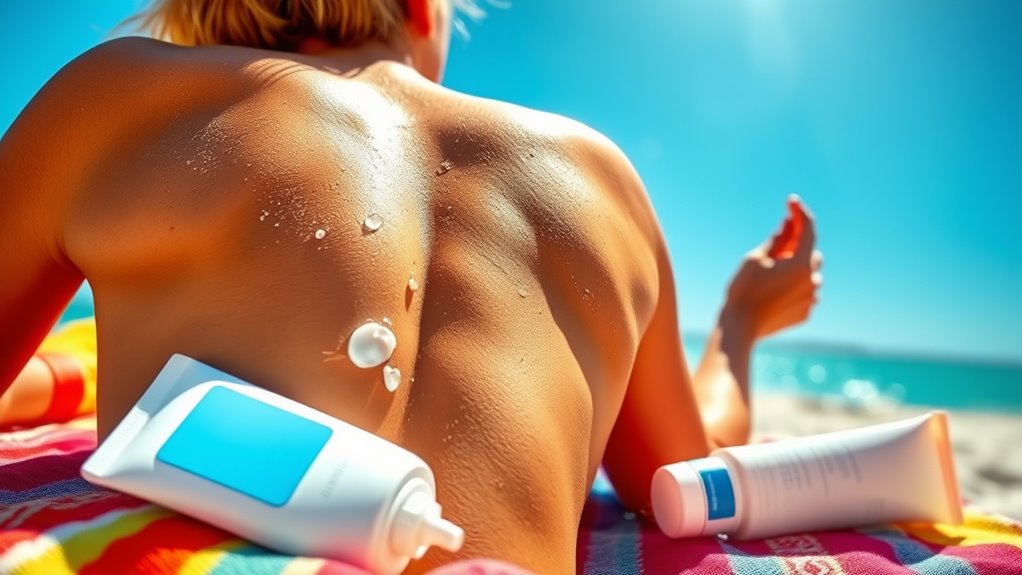
Many people forget to cover hidden spots like ears and the back of the neck, leaving skin vulnerable. You should double-check all exposed areas to make certain no spots are missed. Complete coverage is essential for effective sun protection. Ensuring your sunscreen application accounts for all exposed areas can help prevent overlooked spots. Additionally, understanding city dynamics can help you stay mindful of sun exposure during outdoor activities. Being aware of lifestyle factors such as outdoor routines can further enhance your sun safety efforts. Incorporating knowledge about UV radiation levels can also guide you in adjusting your sun protection strategies based on the environment.
Hidden Spots Often Missed
Even when you’re diligent about applying sunscreen, it’s easy to overlook certain areas that are just as exposed to the sun. For example, the tops of your feet often get neglected, especially if you’re wearing sandals. The backs of your knees can also be missed, despite their vulnerability. Don’t forget about your scalp if you have thinning hair or a part. Your lower back and the sides of your torso are common blind spots, especially if you’re wearing clothing that covers the front. Additionally, the backs of your arms and your hands tend to be forgotten, leaving them unprotected. These hidden spots may seem minor, but they’re exposed to UV rays just as much, increasing your risk of sun damage and skin issues. Remember that electric dirt bikes can reach high speeds, so if you’re riding without proper sun protection, your skin could be vulnerable during outdoor rides. To ensure comprehensive coverage, it’s important to understand the significance of proper sunscreen application techniques and how they can prevent missed spots. Using layering sunscreen effectively can help cover all exposed areas thoroughly. Incorporating a regular sunscreen reapplication routine can also significantly enhance protection, especially during prolonged outdoor activities. Pay close attention to these often-missed areas to stay fully protected.
Don’t Overlook Ears and Neck
While it’s easy to remember to protect your hands or face, many people forget to cover their ears and neck, leaving these areas vulnerable. These spots are often overlooked but are just as exposed to UV rays. If you skip applying sunscreen here, you risk burns and long-term damage. Keep in mind that ears and neck can be tricky to cover evenly, especially when moving around or sweating. Proper coverage is essential because cultural awareness about sun protection varies across different regions and communities, affecting how diligently people protect these areas. To emphasize their importance, consider this:
| Area | Why it matters |
|---|---|
| Ears | Sensitive skin, prone to burns |
| Neck | Frequently exposed, often missed |
| Overlooked areas | Increase risk of sun damage |
| Proper coverage | Protects against premature aging |
In addition, understanding sun exposure patterns can help you better time your sun protection efforts. Recognizing regional differences in sun intensity and outdoor habits can improve your overall sun safety routine. Make sure to give these areas thorough coverage for full protection. Applying sunscreen correctly involves covering all exposed skin to prevent UV damage, which can lead to skin aging and increased cancer risk. Additionally, educating yourself about sun safety can help reinforce the importance of thorough application.
Ensure Complete Body Coverage
To make certain you’re fully protected from UV rays, you must cover all exposed skin, not just the obvious areas like your face and arms. Many people forget spots like your back, shoulders, and even your legs, especially if you’re wearing shorts or a skirt. Don’t overlook areas like your feet, behind your knees, or the tops of your ears. Make sure to apply sunscreen generously and evenly to every exposed part, including tricky spots like your hairline or the back of your neck. Reapply as needed, especially after swimming or sweating. Remember, UV rays can reach areas you might not think about, so take the extra time to cover every inch of skin exposed to the sun. This way, you maximize your protection and reduce your risk of sun damage. Being mindful of skin coverage can significantly improve your overall sun safety practices. Paying attention to application technique ensures even coverage and better protection against harmful rays. Additionally, using broad-spectrum sunscreen with adequate SPF can further enhance your defense. Regularly inspecting your skin for any unusual spots or changes can help catch potential issues early and is an important part of sun safety awareness.
Not Reapplying After Water or Sweat

When you get out of the water or start sweating, your sunscreen can lose its effectiveness. Water and sweat wash away or break down the SPF, leaving your skin unprotected. To stay protected, you need to reapply sunscreen promptly after these activities.
Water Washes Away SPF
Water can easily wash away sunscreen, especially if you don’t reapply afterward. When you swim, splash, or even sweat in water, the protective layer often gets rinsed off. Without reapplication, your skin becomes vulnerable to UV rays. To stay protected, keep these tips in mind:
- Jump out of the water and reapply sunscreen immediately after swimming or sweating.
- Use water-resistant sunscreen if you plan to be in or around water.
- Remember that even water-resistant formulas need reapplication every two hours, or more often if you’re active.
Failing to reapply after water exposure leaves your skin unprotected, increasing your risk of sunburn and long-term skin damage. Stay vigilant, and always refresh your SPF when water’s involved.
Sweat Reduces Effectiveness
Even if your sunscreen is water-resistant, sweating can still weaken its protective barrier. When you sweat, it doesn’t just cool you down; it can wash away or dilute the sunscreen on your skin. This reduces the SPF’s effectiveness, leaving you vulnerable to UV rays. Heavy sweating, like during exercise or outdoor work, accelerates this process. If you don’t reapply sunscreen after sweating, you risk exposing your skin to harmful UV radiation. To stay protected, reapply sunscreen immediately after heavy sweating or swimming, even if the bottle claims water resistance. Remember, sweat doesn’t necessarily remove all sunscreen, but it can markedly diminish its protection. Regular reapplication ensures your skin remains shielded throughout your time outdoors.
Relying on Sunscreen Alone for Protection

Relying solely on sunscreen for sun protection can be a risky mistake because it gives a false sense of security. Many believe applying sunscreen is enough to stay safe, but it’s just one part of a thorough approach. Sunscreen can wear off, be applied unevenly, or be ineffective against certain rays. To truly protect your skin, you need more than just lotion.
Relying only on sunscreen risks false security; wear protective clothing and seek shade for real sun safety.
Consider these additional steps:
- Wearing protective clothing, like hats and long sleeves
- Seeking shade during peak sunlight hours
- Avoiding tanning beds and reflective surfaces
Using Expired or Poor-Quality Sunscreen

Using expired or poor-quality sunscreen can seriously undermine your sun protection efforts. When sunscreen expires, its active ingredients break down, reducing its ability to block UV rays effectively. You might think it still offers protection, but in reality, it leaves your skin vulnerable. Poor-quality sunscreens often lack the proper SPF or fail to contain sufficient UV filters, meaning you’re not adequately protected. Always check the expiration date before applying, and discard any sunscreen that has passed its date. Also, choose reputable brands with proven ingredients for reliable coverage. Remember, using expired or cheap products can give you a false sense of security, increasing your risk of sunburn and skin damage. Investing in quality, fresh sunscreen ensures you’re getting the protection you need when it counts most.
Applying Sunscreen Too Late Before Sun Exposure
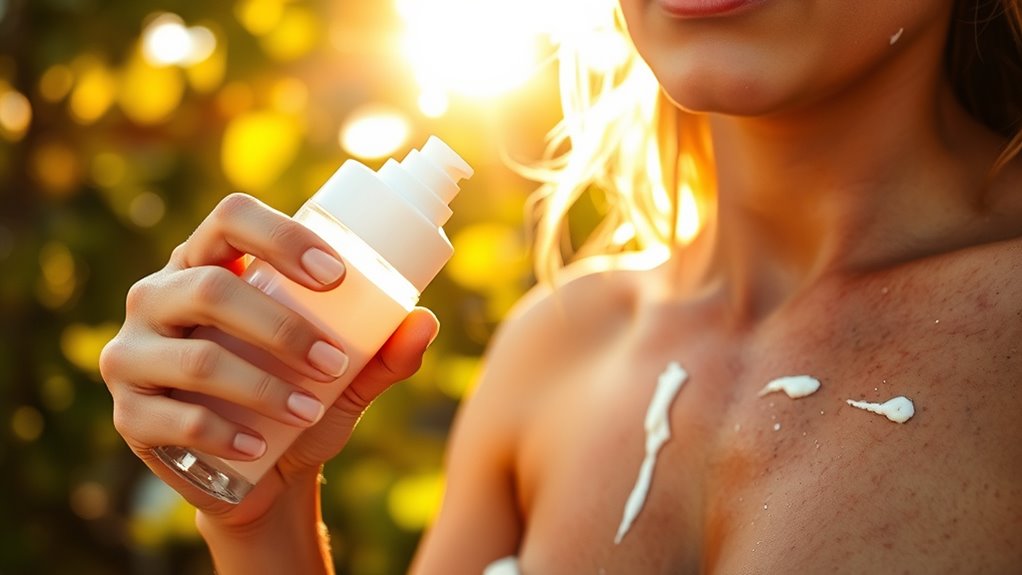
Applying sunscreen too late before sun exposure can considerably reduce its effectiveness. When you don’t apply it at least 15-30 minutes beforehand, your skin isn’t fully protected when the sun hits. This delay allows harmful UV rays to penetrate your skin, increasing your risk of burns and long-term damage. To maximize protection, consider these tips:
- Apply sunscreen early, ideally 15-30 minutes before going outside.
- Don’t wait until you’re already in the sun to put it on.
- Reapply every two hours or after swimming or sweating.
Skipping this step or delaying application leaves your skin vulnerable right when it needs protection most. Proper timing guarantees your sunscreen forms a barrier before UV rays can cause harm. Remember, early application is key to staying safe in the sun.
Ignoring the Need for Broad-Spectrum SPF

Many people overlook the importance of choosing a thorough-spectrum SPF when selecting sunscreen, but failing to do so leaves your skin vulnerable to more than just UVB rays. UVA rays penetrate deeper, contributing to premature aging, wrinkles, and skin damage. If your sunscreen only protects against UVB, you may not notice immediate effects, but over time, your skin suffers. Broad-spectrum sunscreens shield you from both UVA and UVB radiation, reducing the risk of sunburn, skin cancer, and long-term damage. Always check the label to confirm it’s labeled “broad-spectrum” and has an SPF of at least 30. Skipping this step leaves you unprotected against the full spectrum of harmful rays, increasing your risk of skin issues down the line. Protect your skin comprehensively by choosing the right sunscreen.
Failing to Rub in Sunscreen Completely

Failing to rub in sunscreen completely can substantially reduce its effectiveness, leaving patches of skin unprotected. When you skip thorough application, UV rays can penetrate these areas, increasing your risk of sun damage. To ensure full protection, make sure to:
- Spread the sunscreen evenly across all exposed skin
- Pay special attention to tricky spots like around your ears and neck
- Use enough product to create a thin, visible layer
Neglecting to blend sunscreen properly can create gaps where UV rays can sneak through. Even if you’ve applied a generous amount, uneven coverage defeats its purpose. Take the extra moment to massage it in well—your skin needs full, uniform coverage to provide the best defense against harmful rays.
Neglecting to Reapply During Extended Sun Exposure
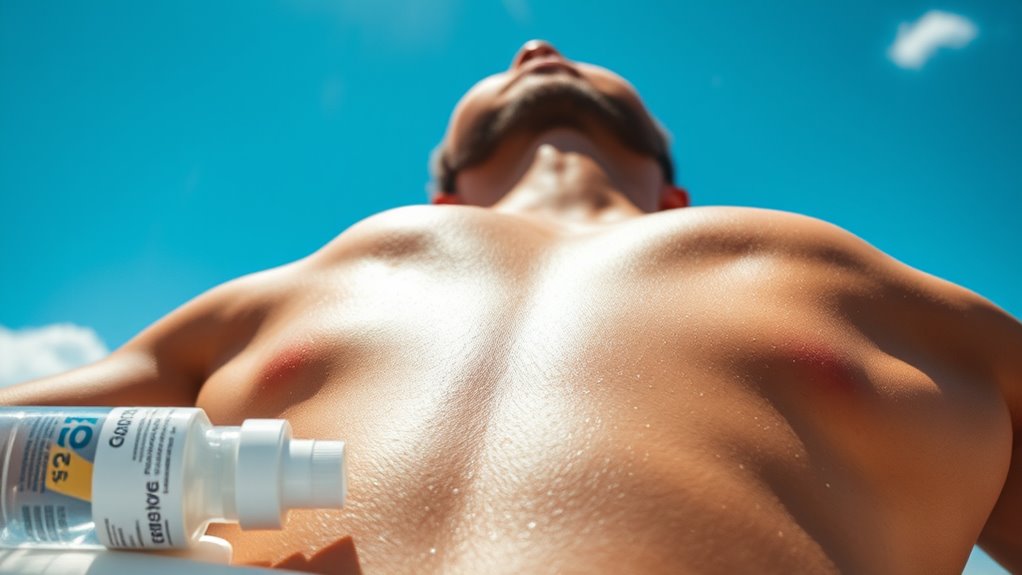
You often forget that sunscreen wears off quickly, especially after sweating or swimming. Without a backup or reminder, you might miss reapplying at the right time. Skipping reapplication during extended sun exposure considerably increases your risk of sun damage.
Sunscreen Wears off Quickly
Have you ever noticed how sunscreen seems to stop working after a while? It’s because it wears off faster than you think, especially when you’re active or sweating. Without reapplying, your skin becomes vulnerable to UV rays, increasing your risk of sunburn and damage. To stay protected, keep these tips in mind:
- Reapply every two hours, or immediately after swimming or sweating
- Use enough sunscreen to cover all exposed skin
- Choose a broad-spectrum sunscreen with at least SPF 30
Skipping reapplication during extended sun exposure leaves your skin unprotected, even if you applied sunscreen initially. Remember, sunscreen isn’t a one-and-done solution; regular reapplication is key to staying safe under the sun.
Forget to Carry Backup
Forget to carry a backup sunscreen or reapplication supplies can leave your skin unprotected during long hours in the sun. Even if you applied sunscreen correctly at the start, extended exposure demands regular reapplication. Without a backup, you risk missing essential reapplication times, increasing your chances of sun damage. Always pack extra sunscreen, especially when planning outdoor activities. To help you stay organized, consider this checklist:
| Item | Purpose | Tips |
|---|---|---|
| Travel-sized SPF | Easy to carry for reapplication | Reapply every 2 hours |
| Reusable spray | Quick and even coverage | Keep in a waterproof bag |
| Towelettes | Convenient for touch-ups | Use when reapplying isn’t feasible |
Being prepared ensures continuous protection and keeps your skin safe.
Reapplication Schedule Overlooked
Even with a well-stocked supply of sunscreen, neglecting to reapply during extended sun exposure leaves your skin vulnerable. UV rays can break down sunscreen quickly, especially if you’re sweating or swimming. Failing to reapply means your protection diminishes, increasing your risk of sunburn and skin damage. Keep in mind:
- Reapply every two hours, or immediately after swimming or sweating
- Don’t skip reapplication on cloudy days—UV rays penetrate clouds
- Remember to cover often-missed areas like ears, back of neck, and hands
Sticking to a reapplication schedule ensures continuous protection. If you ignore this, you’re risking premature aging, sunburn, or worse. Stay vigilant and reapply regularly to keep your skin safe under the sun’s rays.
Frequently Asked Questions
How Can I Tell if My Sunscreen Has Expired or Gone Bad?
You can tell if your sunscreen has expired or gone bad by checking its packaging for a printed expiration date. If there’s no date, look for changes in color, texture, or smell—if it’s thinned out, separated, or has a sour odor, toss it. Also, if the consistency feels different or it doesn’t spread smoothly, it’s time to replace it. Using expired sunscreen reduces your protection against UV rays.
Is There a Difference Between Water-Resistant and Waterproof Sunscreen?
Ever wondered if water-resistant and waterproof sunscreens are the same? Water-resistant sunscreens hold up for about 40 to 80 minutes when you’re sweating or swimming, while waterproof options claim to last longer, though no sunscreen is fully waterproof. You should choose based on your activity—if you’re in water a lot, opt for waterproof. Always reapply after swimming or sweating, regardless of the label.
What Are the Best Techniques for Evenly Applying Sunscreen on Difficult Areas?
When applying sunscreen on tricky spots, you should start with generous amounts and use your fingertips or a clean brush for better control. Gently spread the product in circular motions, ensuring even coverage without missing corners. Pay special attention to areas like behind your ears, around your nose, and under your chin. Reapply regularly, especially after sweating or swimming, to keep those spots protected.
How Long Does Sunscreen Typically Provide Protection Before Needing Reapplication?
Think of sunscreen like a sponge soaking up sun protection—eventually, it dries out. Typically, sunscreen offers protection for about two hours, but if you’re sweating, swimming, or towel-drying, you should reapply sooner. To stay protected, reapply every two hours, or immediately after water activities or excessive sweating. This way, you’ll keep your skin safe, just like a shield that never lets its guard down.
Can I Use Moisturizers With SPF Instead of Sunscreen?
You might think moisturizers with SPF are enough for sun protection, but they often don’t provide the same level of coverage as dedicated sunscreen. Moisturizers focus on hydrating your skin, while sunscreens are formulated to block UV rays effectively. To stay properly protected, use a broad-spectrum sunscreen underneath your moisturizer, especially during prolonged sun exposure, rather than relying solely on moisturizers with SPF.
Conclusion
To stay protected, think of sunscreen like your shield in the sun’s battlefield—missing a spot leaves you vulnerable. Avoid rushing or skipping steps, and don’t forget to reapply like invigorating your armor. By covering all areas, choosing broad-spectrum SPF, and being diligent, you’ll keep the sun’s rays at bay. Remember, proper application is your best defense—think of it as building a fortress that stands strong against UV damage.









